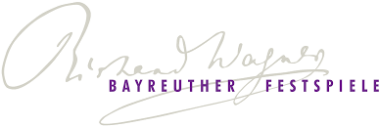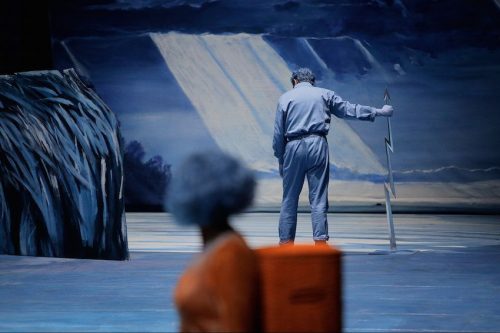
 Germany Bayreuth Festival 2019 [2] – Wagner, Lohengrin: Soloists, Chorus and Orchestra of the Bayreuth Festival / Christian Thielemann (conductor). Festspielhaus, Bayreuth, 14.8.2019. (JPr)
Germany Bayreuth Festival 2019 [2] – Wagner, Lohengrin: Soloists, Chorus and Orchestra of the Bayreuth Festival / Christian Thielemann (conductor). Festspielhaus, Bayreuth, 14.8.2019. (JPr)

Production:
Director – Yuval Sharon
Stage design and Costumes – Neo Rauch and Rosa Loy
Lighting – Reinhard Traub
Chorus conductor – Eberhard Friedrich
Cast included:
Heinrich der Vogler – Georg Zeppenfeld
Lohengrin – Piotr Beczała
Elsa von Brabant – Annette Dasch
Friedrich von Telramund – Tomasz Konieczny
Ortrud – Elena Pankratova
Herald – Egils Silins
Four nobles – Michael Gniffke, Tansel Akzeybek, Marek Reichert and Timo Riihonen
Yuval Sharon’s Lohengrin returned for its second outing and little seemed to have changed little from last year (review click here). I mentioned then how the starting point for the – often two-dimensional – designs of Neo Rauch and Rosa Loy was Friedrich Nietzsche describing the colour of the opera’s ethereal prelude as blue ‘of opiatic, narcotic effect’, according to them. Blue this Lohengrin certainly is, very blue!
More informative about the production in its entirety is how Sharon explains in this year’s programme that in his opinion ‘Lohengrin continues developing the central idea from Tannhäuser, that blind conformity is the enemy to the full, free development of the individual – but unlike his previous opera, Wagner represents the glory and the suffering of the fully realised individual not in the figure of the title hero but in his women, Elsa and Ortrud.’
Regardless, for most of the opera there is much ‘Delft Blue’ and the costumes have the stiffened collars familiar from the seventeenth-century paintings of Anthony van Dyke.
As I also mentioned previously Wagner’s Lohengrin blends history and myth, doubt and tragedy. Friedrich von Telramund accuses Elsa of Brabant of murdering her brother Gottfried. King Henry vacillates and commands a trial by combat. Who will be Elsa’s champion, none other than the mysterious knight, Lohengrin, who she has dreamt of and now fortuitously arrives. He spares Telramund and marries Elsa, having imposed a vow of silence on her ordering her not to questioning his identity or where he has come from. Seeking their revenge, Telramund and his wife Ortrud sow increasing doubt in Elsa’s mind and eventually she asks Lohengrin what he has told her not to. He is Lohengrin, Parsifal’s son and is helping her bound by the laws of the Holy Grail. He must remain anonymous and if not must return to where he came from, Montsalvat. Lohengrin departs never to return, but his prayers release Gottfried from Ortrud’s spell.
For Act I there is a huge central transformer station and we see a society where having a pair of wings seems to allow not only flight but signify increased status or power, and even some control over life or death itself. Telramund loses one of them when Lohengrin – wielding a sword in the shape of a lightning bolt – defeats him in a rather comical aerial confrontation (between two stunt doubles) and as a result Lohengrin literally is conferred his ‘wings’. Throughout there remains a slightly unease mix of new technology with age-old customs. Elsa is tied up against two large ceramic insulators and seems to be being threatened both with electrocution and immolation until magically being released when Lohengrin arrives in his blue workman’s overalls. This – again literally – provides the spark this ‘society’ needs. Intriguingly there is a sort of Gotham City Bat-Signal atop the power plant, but it is white and represents the swan. It is not seen again.
In Act I we begin to see the focus Sharon puts on the women in this opera and at one point the King appears to reach out to Elsa in friendship now her innocence is proven, but she is seen to contemptuously dismiss this attempt at reconciliation. The chorus sing wonderfully of course but are often very static throughout the opera and are mostly confined to the sides of the stage with only a few hand gestures – especially from the women – appealing to the King for Elsa to be spared, rejoicing at Lohengrin’s success, or giving silent applause at the Act II wedding.
The start of Act II is still very dark and it is difficult to see what is happening. There is the outline of trees and dense undergrowth crisscrossing the front of the stage with a castle turret in the background that Elsa looks out from when she sings. The scheming Ortrud – complete with handbag – not so much wraps Telramund round her little finger as binds him with a rope until she persuades him on their next course of action. For the cathedral steps everything opens up and we are at the rear of the power plant. Its huge girders (orange not blue!) and some gangways still limit any possible movement and there is a little too much standing around and singing once again.
With her hands bound Elsa is the epitome of a very reluctant bride and all Ortrud’s misgivings – she now has gnat-like wings – do nothing to alleviate how conflicted Elsa is about the impending marriage. What we now get – if we can ignore the mise-en-scène – seems a very conventional staging. Lohengrin even has as a shiny breastplate to complete his appearance as the definitive Wagnerian romantic hero figure. There were longueurs in this act that Sharon did nothing to overcome but it was possible to luxuriate in the magnificent orchestra and stunning choral singing even when you were not fully engaged by the drama.
Conversely with Act III focussing mainly on Lohengrin and Elsa it was compelling from beginning to end. It was the performances of two wonderful singing-actors – Piotr Beczała and Annette Dasch – that made it impossible not to get swept up in what was happening. We are now inside what – still for me – looks like the TARDIS from the BBC TV sci-fi series Dr Who. It appears disguised not so much as a police box but as an electricity substation with a vivid orange interior. Lohengrin divests himself of his breastplate and wings and I still think the books we see them read must be 50 Shades of Blue because as Elsa’s paranoia increases Lohengrin engages in some bondage. He restrains her with some rope as, now totally distraught, Elsa asks the forbidden questions. When Lohengrin gets attacked by Telramund’s firefly-like henchmen there seems to be a circuit overload and his attacker simply drops dead.
For the final scene there is a tall pylon with a lake to the rear and an electrical grid in the distance. Lohengrin reappears looking like a workman again and time seems to stand still. If Bayreuth has heard a better ‘In fernem Land’ than Beczala’s I would have liked to have been present and certainly I haven’t in my 30 years there! Almost using half a voice and lying on the stage Lohengrin’s tale is told with increasing intensity and it allowed the audience to experience with him ‘eine Taube’ (a dove) descending from heaven. ‘Mein lieber Schwan’ – sung from the back of the stage – was equally gripping. Sadly, Elena Pankratova’s ‘Fahr heim!’ disappointed and did not have Petra Lang’s impact in the last Hans Neuenfels rat-infested production (available on YouTube).
This all ushered in Sharon’s ending that leaves the audience scratching its head. Lohengrin gives Elsa a powerpack; Ortrud is about to be burnt herself as a witch before all the Brabantines appear to be electrocuted and drop dead when Gottfried returns looking like a form of green energy. This leaves a bemused Elsa, Ortrud and Gottfried as the only survivors.
At Bayreuth in 2019 there have been cast changes upon cast changes for this Lohengrin. Annette Dasch replaced the originally announced Anna Netrebko and was an improvement on Anja Harteros last year. There was a limpid quality to her ‘Einsam in trüben Tagen’ that made it the out-of-body experience it must be. Tomasz Konieczny repeated his forthright Alberich-like Telramund; the always dependable Georg Zeppenfeld was an authoritative King Henry; and Egils Silins was a strong-voiced declamatory Herald. Elena Pankratova overall was a very Machiavellian Ortrud clearly experiencing great delight in plotting Elsa’s misery.
Best of all was Piotr Beczala as Lohengrin who sang throughout with a winning blend of Italianate lyricism and robust power. There is a bit of heroic tenor bronze to his middle register and – as I wrote last year – he gave all the words he was singing the attention they deserved.
Christian Thielemann was conducting for the second successive night (review click here) and in totally command, as expected, of a superb chorus and orchestra. The Bayreuth Festival Chorus – so important in Lohengrin – sang with refinement and complete discipline while all sections of the orchestra played Wagner’s score virtuosically. Thielemann himself manages to give an overriding unity to a work that can, in lesser hands, sprawl and the well-known Prelude to Act III and the ‘Bridal Chorus’ were memorably celebratory.
Jim Pritchard
For more about the Bayreuth Festival click here.